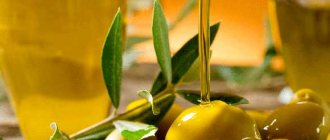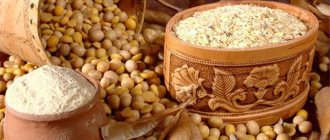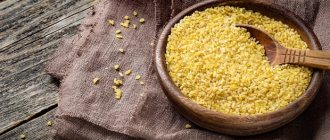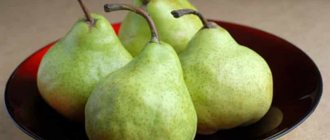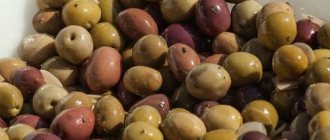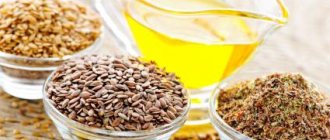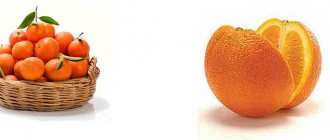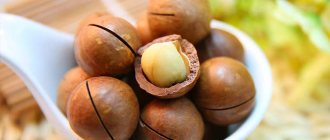Even in ancient times, the great poet Homer called this product “liquid gold”, because compared to other vegetable oils it occupies a leading position in the content of monounsaturated fats. It is actively used in medicine, cosmetology, and weight loss diets. The largest producers are Spain, Greece, Italy, France, Cyprus, Turkey, the USA and North African countries. The Russian and Ukrainian food markets come from Spain and Italy. Olive oil (wood, Provençal) is obtained from the fleshy part of the fruit of the olive tree, as well as from the kernel of its hard pit.
The best food grade is considered to be the one obtained by cold pressing (this is evidenced by the inscription on the label “first cold press”), it is called “Extra Virgin Olive Oil”.
Purified (“refined”) is obtained using physicochemical processes aimed at eliminating strong taste and acid content.
Oil made from pressing through chemical solvents (hexane) and high temperature is called pomace olive oil. For more information about the types and correct choice of oil, read the article “How to choose the right olive oil?”
Calorie content of olive oil and chemical composition
The calorie content of olive oil per 100 g is 897.8 kcal, and the chemical composition is rich in fatty acids and has an extensive list of beneficial effects on the human body.
Chemical composition of unrefined oil per 100 g in table form:
| Item name | Quantitative indicator |
| Omega-6, g | 11,8 |
| Oleic, g | 63,8 |
| Palmitoleic, g | 1,61 |
| Palmitic, g | 12,8 |
| Arachidonic, g | 0,79 |
| Stearic, g | 2,8 |
| Iron, mg | 0,5 |
| Choline, mg | 0,4 |
| Vitamin E, mg | 12,3 |
| Vitamin K, mg | 0,07 |
| Phosphorus, mg | 2,1 |
| Potassium, mg | 1,1 |
| Sodium, mg | 1,9 |
| Calcium, mg | 1,2 |
| Beta Sitosterol, mg | 99,8 |
| Linoleic, g | 12,1 |
| Omega-9, g | 0,6 |
During processing, olive oil wastes a large number of beneficial elements, so for cosmetic or medicinal purposes it is best to use unrefined oil.
Nutritional value of olive oil per 100 g:
- carbohydrates – 0 g;
- fats – 98.9 g;
- proteins – 0 g;
- dietary fiber – 0 g;
- water – 1.1 g.
The BZHU ratio is 0/1/0, respectively. The calorie content of 1 tablespoon of oil is 152.6 kcal, in 1 teaspoon - 44.8 kcal.
Content of vitamins and microelements
Olive oil is considered a very valuable food product. It contains a lot of substances that are beneficial for the body. The vitamin composition includes the entire complex: vitamin A, vitamin C, vitamin E, F, K, group of vitamins B. All the main micro and macroelements are also available - iron, calcium, magnesium, manganese, selenium, copper, zinc . In addition, the product is rich in various organic substances. It contains a lot of unsaturated fatty acids. The main fatty acids in the oil include Omega 6, Omega 7 and Omega 9, which are very beneficial for health.
Benefit for health
The benefits of using olive oil for human health are great and multifaceted. The product not only improves overall well-being, but also has a beneficial effect on almost internal organs, normalizing their functioning and acting as a preventative against various diseases.
- Olive oil reduces the level of bad cholesterol in the blood and increases the amount of good cholesterol. In addition, the product strengthens the heart muscle. Scientific research shows that people who regularly consume foods rich in fatty acids have a reduced risk of developing cardiovascular disease.
- The product has an anti-inflammatory effect on the body. Inflammatory reactions often occur due to constant stress, irregular or unhealthy diet, and then develop into more serious diseases. The oil helps neutralize the effects of inflammatory processes, as well as reduce the frequency of their occurrence.
- The oil has a positive effect on the strength of the walls of blood vessels and also normalizes blood pressure.
- Thanks to its antioxidant properties, olive oil is used to prevent cancer.
- Olive oil helps you lose weight and is considered an excellent preventative against obesity, of course, if you consume the product in moderation.
- Increases brain performance. Systematic consumption of oil, regardless of whether in its pure form or as a dressing for dishes, improves memory, concentration and attentiveness.
In addition, the oil acts as a preventative against Alzheimer's disease - it slows down the decline in cognitive function.
© Lukas — stock.adobe.com
Varieties and their differences
All olive oils are divided into three main types:
- Natural – ordinary or virgin oils, first and second cold pressed. It is obtained by applying certain temperatures and only by physical means. Used mainly for dressing salads or in sauces.
- Refined – refined oil or a mixture of refined and extra virgin olive oils. It is extracted from the pulp of damaged olives through physical and chemical processing and cleaning them from a specific taste. Used for frying or baking.
- Pomace oil is oil made from pomace. It is the result of an extraction process from the cake and is the least suitable of all the listed varieties for use for culinary purposes, most often used in baking or frying.

Medicinal properties of olive oil
The healing properties of olive oil have long been used in folk medicine:
- Regular use of the product prevents depression and nervous disorders. The oil normalizes hormonal balance, due to fluctuations in which the mood often deteriorates for no reason. In addition, by systematically taking the oil, you can strengthen your sleep and achieve positive thinking.
- It is believed that olive oil reduces the risk of diabetes. The fats included in the product normalize sugar and insulin levels. If you like foods that are rich in sugar and carbohydrates, you can slow down the process of glucose entering the bloodstream with a small amount of oil.
- Olive oil normalizes digestion, prevents constipation and bloating, and helps in the treatment of intestinal diseases.
- The use of the product helps to restore strength after surgery or a serious illness.
- Oil removes poisons, toxins and excess salts from the body. Moreover, the product will help cleanse the respiratory tract and reduce the negative effects of nicotine on the lungs.
- Regular consumption of oil reduces the appearance of varicose veins and prevents its development due to its ability to thin the blood. The product prevents the formation of blood clots and makes the walls of blood vessels more elastic. In addition, the oil is used externally for rubbing into the skin in areas where varicose veins appear.
- The product treats gum inflammation. To do this, you need to heat the oil (slightly warmer than room temperature) and lubricate the gums with a soft toothbrush. If the operation is painful, you can simply rinse your mouth with warm oil for 10-12 minutes.
Oil belongs to a small list of products that are almost 100% absorbed by the body due to their diverse chemical composition, the components of which contribute to the rapid absorption of each other. For example, the antioxidants it contains help the body absorb vitamin K.
For women's health
Olive oil has a positive effect on women's health:
- Regular addition of the product to the diet normalizes hormonal balance, which fluctuates during menopause or before PMS.
- The oil is used in the treatment of infertility. For these purposes, special diets often include a product high in fatty acids and nutrients, and olive oil is a champion in this area.
- The functioning of the thyroid gland and the production of estrogen are normalized.
- The oil is recommended to be consumed during pregnancy, as it will have a positive effect not only on the well-being of the mother, but also on the baby. In addition, the product helps fight chronic fatigue.
During breastfeeding, consuming oil will reduce the occurrence of colic in the baby.
Olive oil for men
Olive oil also has beneficial effects on men's health:
- Regular use of the product will improve potency by increasing blood circulation.
- The product improves reproductive function.
- The oil energizes you before grueling sports training.
The oil is especially useful for strength athletes who need to gain muscle mass or show the best results in competitions.

© Visions-AD - stock.adobe.com
Harm
The benefits of olive oil for the body are very great, but it should be added to the diet in small quantities. Otherwise, it may have a bad effect on your stomach. Has a choleretic effect. For example, with cholecystitis, the disease may worsen. An adult, without harm to health, can consume about 3 tablespoons per day.
It is better to choose and buy unrefined, which has been subjected to less heat treatment and retains many more useful elements in its composition than refined. But such oil is also much more expensive. It is better to give preference to natural olive oil, always in glass containers.
Some manufacturers cheat and mix different varieties, which greatly reduces the beneficial composition and properties of the oil. If the product label says mix, then it is better not to buy it. It is important to remember that the shelf life of high-quality unrefined oil is no more than five to six months.
Application in cosmetology
In cosmetology, olive oil is used to improve skin condition, strengthen hair and eyelashes:
- To increase the thickness of your eyelashes, simply lubricate your eyelashes with olive oil every day before going to bed. After a month of use, the first results should be noticeable. In addition, the oil is used as a makeup remover.
- To get shiny and thick hair, as well as to make it soft and stimulate further growth, you need to make masks based on nourishing cream and olive oil, rubbing them into the roots and evenly distributing them along the length of the hair.
- The oil moisturizes the skin and protects against harmful environmental influences, such as ultraviolet radiation and toxins, and also prevents flaking and roughening. Moreover, simply regular consumption of unrefined olive oil helps, but if you make hand or face creams with the addition of oil, the effect will increase significantly.
- The oil is used in body wraps and anti-cellulite massage procedures. These same steps will help make stretch marks less noticeable.
- At home, you can get rid of acne or redness, but only if you do not have oily skin, otherwise the pores will simply become clogged and irritation will increase.
In addition to the above, the product accelerates wound healing and relieves pain and redness from minor burns. For cosmetic effects, use unrefined, cold (first) pressed oil.
Olive story
Content:
- Olive story
- Types of olive oil
- Chemical composition
- Beneficial features
- Use in folk medicine
- Use in cosmetology
- How to choose the right one
- Some Caveats
It is difficult for researchers to say when and where olive trees were first “domesticated,” but both legends indicate that this plant has been known to people since very ancient times. Even during the Neolithic period, the peoples inhabiting the Mediterranean collected olives (and this is 8000 BC). Historians attribute the “cultivation” of olives to the inhabitants of Asia Minor, the Levantines or Mesopotamians. And this must have happened between 6000 and 3000. BC e.
The recipe for making olive oil has been known to mankind since at least 4500 BC. e. Historians suggest that already during this period, oil was made from olives in the territory of modern Israel. At one time, archaeologists came across an amazing find - an amphora with an olive product made around 3500 BC. e. Minoans. By the way, it is believed that this ancient civilization became rich thanks to olive oil, which was produced for export.
If you believe the ancient records, then in 1500 BC. e. Greece was the largest producer of the olive product. In ancient times, oil was squeezed out of olives by hand, so it was highly valued. The first presses for the production of this product date back to approximately 700 BC. e. At least, these are the most ancient presses that archaeologists have been able to find. More precisely, near Jerusalem, researchers discovered more than 100 such structures.
To say that in ancient times this product was highly valued is an understatement. The Greeks called it “liquid gold,” the Jews used a mixture based on olive oil in the coronation ceremony of kings, the Spartans rubbed this product into the skin to make it soft and emphasize their physical characteristics, and in the Roman Empire this product was even used as an offering to the emperor.
It was the ancient Romans who developed the screw press to produce olive oil, a technology that is still used in some regions today.
Nowadays, the best producers of olive oil are Italy, Spain, Greece, Turkey, Portugal, Morocco and American California.
How to use when losing weight?
To lose weight, it is recommended to drink 1 tsp on an empty stomach. unrefined olive oil. Over time, the dose is increased to 1 tablespoon. After taking the oil, it is strictly forbidden to eat or drink anything for 40, or preferably 60 minutes. Otherwise, it will be impossible to achieve the desired result. Optionally, when your body gets used to the morning dose of 1 tbsp. spoon, you can add another dose of oil at night in the same amount (but you need to start again with 1 tsp).
The tendency to overeat appears in humans, among other things, due to a lack of oleulethanolamide in the body. When olive oil begins to interact with the intestinal mucosa, it acts as a catalyst, thanks to which the production of this substance begins.
The essence of the technique is that by saturating the body with essential fatty acids, you will prevent the possibility of overeating and reduce the number of unnecessary snacks: the feeling of fullness in the stomach will remain for a longer time.
Important! To lose weight, use unrefined oil. But it is better not to use such oil for heat treatment of food.
In addition, you can take one tablespoon of oil mixed with lemon juice. This will cleanse the liver of accumulated bile, improve its functioning, and therefore speed up the process of losing weight.
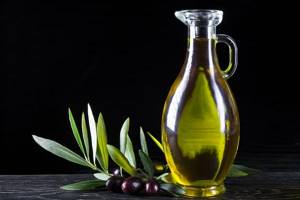
© Angel Simon — stock.adobe.com
How to select and store
How to choose good quality olive oil:
- The first thing you should pay attention to is the color of the product. Ideally, olive oil should have a pleasant golden hue that shimmers slightly in the sun. In no case should the color of the oil have yellow or gray tints - they are a sign of low quality, and may also indicate counterfeiting (for example, when a manufacturer tries to sell rapeseed oil or a mixture of other different types of oils under the guise of olive oil).
- The second important selection criterion is the abbreviations and inscriptions on the bottle. If you are looking for a product with the maximum range of beneficial properties, then you should pay attention to those oils whose label will contain the inscription “Extra virgin” or the abbreviation DOP - both of these designations indicate that the product is made from the best varieties of olives and is ideal for for use in both culinary and cosmetic purposes.
- Well, the third important indicator of quality is the acidity of olive oil, measured by the percentage of free oleic acid. The following are considered optimal indicators: extra virgin – no more than 0.8%; virgin – no more than 1.5%; refined product – no more than 0.3%.
When choosing olive oil, the date of manufacture, the country of production are also of great importance - the leaders in production are Spain, Italy, Greece, and the container in which the product is sealed - tinted glass is preferable to transparent plastic.
How to properly store olive oil:
- Make sure that the printed container is sealed;
- Control temperature and light protection. The best place to store olive oil is in a cool, dark place, such as a closed cabinet or refrigerator.
Harm from olive oil and contraindications
Harm from olive oil, as from most other substances, in most cases is caused by abuse or the purchase of a low-quality product, as well as an allergy to it. It is contraindicated to consume more than 2 tbsp per day. l. oils:
- People who are obese or on a diet, as the product is high in calories.
- People who have cholecystitis, kidney stones or gall bladder stones should first consult a doctor before consuming the product and should never drink it on an empty stomach.
- When taking the product above the recommended daily dose, your blood pressure may drop critically.
- A low-quality product can cause poisoning and heart failure.
- Abuse can cause stomach upset, the formation of kidney stones, cause inflammation and a critical decrease in blood sugar levels.
In addition, it is worth remembering the high calorie content of oil and consuming it moderately, in doses recommended by nutritionists.
How to choose the best oil?
It is obtained from the fruit of the olive tree. Oil is pressed from both the pulp and the pits of olives. It tastes very soft, delicate, without foreign tastes or unpleasant aftertaste, thick consistency, with a subtle oily aroma. The best product is extracted by cold pressing without any impurities or additives.
There are several types of olive oil:
- natural (extracted by pressing without chemical cleaning and additional heat treatment);
- purified (it is freed from excessively strong taste and unhealthy fats and impurities);
- pomace (the lowest grade of oil obtained from olive pomace using chemicals and heat treatment)
Dietary properties:
What is the calorie content of olive oil, what dietary properties does it have? All this is very interesting for those who are trying to lead a healthy lifestyle and take care of their health and figure. So we will try to answer these questions in the next article.
Replace sources of saturated protein such as butter in your diet with a source of monounsaturated fat such as olive oil. It keeps you full, helps curb your appetite so you eat less, and increases your gut's production of the appetite-regulating hormone CCK. When combined with carbohydrates, this oil helps keep blood glucose and insulin levels low, preventing the body from storing fat.
Olive oil can not only protect your thighs from fat deposits; it can actually increase the body's ability to burn fat. Research shows that foods cooked in olive oil boost fat oxidation much more than foods rich in saturated fat. Experts suggest that monounsaturated fatty acids turn on genes associated with burning and storing fat.
Measure out one hundred milliliters of oil
Vegetable (vegetable) oil is vegetable fats from different parts of plants (fruits, roots and seeds), which is obtained by extraction or pressing. These oils usually include olive, sunflower, flaxseed and other oils. Sunflower oil is a vegetable oil obtained from sunflower seeds.
People use vegetable oil almost every day in everyday life. Therefore, when preparing a dish, you may need 100 ml of sunflower oil. How much will this be, for example, in spoons or glasses and how can they be measured? Not every housewife has measuring containers in her kitchen. And without them, it can seem almost impossible to do it.
Spoons make excellent measuring containers. In addition, tea, dining and dessert rooms will come in handy. The tea room holds 5 ml of oil, the dessert room - 10 ml, and the dining room - 15 ml. Based on these data and making simple calculations, you can understand what's what. 100 ml of vegetable oil - how many tablespoons should be poured into the container? It's simple: it will be six and another two-thirds tablespoon. For reference, there are ten dessert spoons, and twenty tea spoons.
Using glasses you can also measure the required volume. If the glass has a capacity of 200 ml, then it should be filled 3/5, and if it is 250 ml, then 2/5.
100 ml of vegetable oil - how many grams is this? Before this, you can figure out the capacity of the spoons. Of course, first of all, they are cutlery. And at home, spoons are often used by housewives to measure both volumes and weights.
How many calories are in butter?
Olive oil cannot be called a low-calorie product: 100 grams contain 884 kcal. If you intend to include this wonderful product in your diet without increasing the total calorie content of the food eaten per day, then remember: 1 tablespoon, which, by the way, contains 17 grams, weighs 119 kcal, 2 tablespoons - 238 kcal.
In this situation, 100 grams of the product will be enough for one person for a week.
In addition, 100 grams of oil contain 11.2 mg of vitamin E, famous for its antioxidant properties, and 47 mg of vitamin K, which helps strengthen the skeletal system.
However, it would be useful to know that the calorie content of the olive miracle, the content of nutrients and fatty acids in it is determined by both the variety and the method of its production. Only a fresh, high-quality product will bring maximum benefit.
The nutritional value
It is impossible to talk about the calorie content of any product without remembering such a concept as BZHU (the amount of proteins, fats and carbohydrates), which determines the calorie content itself. So, as you know, olive oil is completely free of proteins and carbohydrates, that is, the product is almost 100% vegetable fat, which is absorbed better and faster than animal fat.
100 grams of olive oil contains 99.8 grams of fat, the remaining 0.2 grams is water, which does not provide any energy value to the body. The average adult's daily fat intake is 60 grams. This means that if you consume 100 grams of olive oil, you will exceed your daily fat intake by almost 70%. Although, in turn, per 100 kcal there is only 18.5% fat, that is, the main thing is not to abuse it.
Scrambled eggs while dieting
When planning a diet for weight loss, it is important to consider the nutritional characteristics of dishes. Eggs are recognized as a dietary product because they contain animal protein necessary for a weight loss diet. Protein foods saturate the body with useful microelements, create a feeling of fullness, and reduce appetite. There will be no need for frequent snacks, which contribute to fat gain. At the same time, it is important to observe restrictions on the use of the product; the daily norm includes 1-2 eggs. The remaining ingredients of scrambled eggs or breakfast and dinner dishes can be vegetables and bran.
Fried eggs are contraindicated; the calorie content of sunflower oil is 889 kcal per 100 g of product, and 748 kcal of butter per 100 g of product. The calorie minimum calculated by nutritionists that allows you to reduce body weight is 700-1400 kcal per day. You should limit or eliminate oils from your diet, and replace fried foods with steamed food cooked in a slow cooker and in a non-stick frying pan. You can add a small amount of healthy olive oil and butter to some dishes.
Egg-based dishes increase energy levels in the body, trigger metabolic processes, and supply cells with necessary microelements and amino acids. The composition of the dish provides the following positive effects on the body:
- improvement of the condition of skin, hair, nail plates;
- increase in muscle mass (with physical activity);
- improvement of memory, concentration;
- launching cell regeneration and body rejuvenation processes;
- stabilization of the nervous system due to the presence of B vitamins;
- improving the condition of the visual organs;
- reduction of swelling;
- increasing the plasticity of blood vessels and cell membranes;
- stabilization of oxidation processes in the body;
- strengthening the skeletal system;
- prevention of the development of osteoporosis;
- improvement of metabolic processes in the liver;
- stabilization of energy metabolism;
- regulation of the required insulin level;
- increasing immunity and resistance to colds;
- regulation of acid-base and water balance in the blood;
- blood cell renewal;
- regulation of hormonal sphere.
Spoons or glasses?
So, how to correctly measure 100 ml of vegetable oil? How much will it be if you use standard glasses with a capacity of 200 and 250 ml?
As you know, housewives measure butter not only with spoons. If you need a fairly large volume of oil, then it is more convenient to measure it with other tools in the kitchen. These include glasses and cups. To easily measure portions of oily liquid, a cup whose capacity the hostess knows will be enough.
As a rule, cookware manufacturers do not produce cups of a standard size. But for glass cups, a standard container is used. That's what they call standard. There are two types of standard cups - faceted and thin-walled. They differ slightly in appearance and shape. But in order to measure portions of liquid fat, different containers are important.
It turns out that an ordinary thin-walled glass is 50 ml larger in volume than a faceted glass. And to be absolutely precise, a standard thin-walled glass has a volume of 250 ml, and a standard faceted glass has a volume of 200 ml.
So how much is 100 ml of vegetable oil if measured in glasses? This has already been mentioned above: depending on the capacity of the cups, they should be filled either 2/5 or 3/5.
(884cal) (877cal) (886cal) (885cal) (886cal) (878cal) (884cal) (884cal) (884cal) (889cal) (884cal) (854cal) (884cal .) (883cal.)
The composition of the egg and its beneficial properties
The chemical composition of eggs differs depending on the type of bird and the conditions of their keeping. According to general characteristics, 100 g of product contains:
- 12-13% animal proteins;
- 12% fat;
- 1.07% mineral components;
- 0.67% carbohydrates;
- 85% water.
The substances are absorbed by the body by almost 90%. For dietary nutrition and maintaining stable physical shape, the following components in eggs are important:
- potassium;
- zinc;
- manganese;
- phosphorus;
- iron;
- antioxidants;
- choline;
- amino acids;
- biotin;
- sulfur;
- thiamine;
- riboflavin;
- vitamins A, E, D, K, group B (B2, B6, B12);
- pantothenic acid.
The yolk contains fatty acids:
- polyunsaturated (18%);
- monounsaturated (52%);
- saturated (28%).
In addition to chicken eggs, quail, ostrich, guinea fowl eggs, etc. are offered for sale. When purchasing, it is important to familiarize yourself with the composition, which is usually indicated by the manufacturer on the packaging. The greatest benefit to the body comes from natural products produced on farms in the countryside. The shelf life and quality of ingredients for the diet are important.
